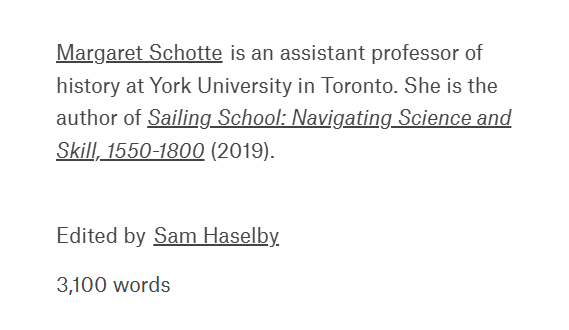Welcome to DU!
The truly grassroots left-of-center political community where regular people, not algorithms, drive the discussions and set the standards.
Join the community:
Create a free account
Support DU (and get rid of ads!):
Become a Star Member
Latest Breaking News
Editorials & Other Articles
General Discussion
The DU Lounge
All Forums
Issue Forums
Culture Forums
Alliance Forums
Region Forums
Support Forums
Help & Search
When pirates studied Euclid

How did the sailors of early modern Europe learn to traverse the world’s seas? By going to school and doing maths problems
https://aeon.co/essays/how-european-sailors-learned-celestial-navigation

Warships in a Heavy Storm (c1695), by Ludolf Bakhuysen. Courtesy Rijksmusuem, Amsterdam

In 1673, in a North Sea skirmish that killed nearly 150 men, the French privateer Jean-François Doublet took a bullet that tossed him from the forecastle and broke his arm in two places. How did the precocious young second lieutenant choose to spend his convalescence? Doublet repaired to the French port city of Dieppe, where he signed up for three months of navigation lessons. This might seem a strange decision; Doublet, who had gone to sea at the age of seven, already knew the ins and outs of navigation. Why would he bother paying for lessons? The school in Dieppe – the Royal School of Hydrography – was renowned for the calibre of its lectures, attracting passing tourists as well as naval trainees. Doublet was keen to learn some more advanced techniques from the teacher, Abbé Guillaume Denys. In his memoir, Doublet explains a practical motive too: if he got injured again, he would retire and open his own sailing school.
Bold adventurers had a chance to enjoy considerable profits at sea in the early modern period (the 16th to 18th centuries) but they also risked their lives on every voyage. For Doublet, it was important to have a backup career plan. He never ended up teaching – he would spend the next three decades traversing the Atlantic and hobnobbing with famous admirals before, as a retirement project, writing his memoir. It might seem surprising that Doublet felt that teaching navigation was on a par with privateering, which was essentially legal piracy, with handsome prize money. Clearly, in the late-17th century, even knowledgeable sailors sought out more education. Records of these early schools are scarce – but Doublet’s detailed account of his time in Denys’s classes offers a rare glimpse into the technical education that early modern European sailors might have received.
During the 16th to 18th centuries, Europeans embarked on thousands of long-distance sea voyages around the world. These expeditions in the name of trade and colonisation had irreversible, often deadly, impacts on peoples around the globe. Heedless of those consequences, Europeans focused primarily on devising new techniques to make their voyages safer and faster. They could no longer sail along the coasts, taking their directional cues from prominent landmarks (as had been common in the preceding centuries). Nor did they have sophisticated knowledge of waves and currents, as did their counterparts in the Pacific. They had no choice but to figure out new methods of navigating across the open water. Instead of memorising the shoreline, they looked to the heavens, calculating time and position from the sun and the stars.
Celestial navigation was certainly feasible, but it required real technical skills as well as fairly advanced mathematics. Sailors needed to calculate the angle of a star’s elevation using a cross-staff or quadrant. They needed to track the direction of their ship’s course relative to magnetic north. Trigonometry and logarithms offered the best way to make these essential measurements: for these, a sailor needed to be adept at using dense numerical tables. All of a sudden, a navigator’s main skill wasn’t his memory – it was his mathematical ability. To help the average sailor with these technical computations, maritime administrators and entrepreneurs opened schools in capital cities and port towns across Europe. Some were less formal arrangements, where small groups of men gathered in the teacher’s home, paying for a series of classes over the course of a winter when they were on shore.

Illustration of a small Dutch classroom from The Golden Light of Navigation (1697), by C H Gietermaker. Courtesy Rijksmuseum, Amsterdam
snip
2 replies
 = new reply since forum marked as read
Highlight:
NoneDon't highlight anything
5 newestHighlight 5 most recent replies
= new reply since forum marked as read
Highlight:
NoneDon't highlight anything
5 newestHighlight 5 most recent replies
When pirates studied Euclid (Original Post)
Celerity
Jun 2025
OP
Biophilic
(6,233 posts)1. Fascinating.
underpants
(193,654 posts)2. Very interesting
Thanks